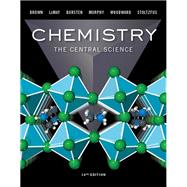NOTE: Before purchasing, check with your instructor to ensure you select the correct ISBN. Several versions of the MyLab™ and Mastering™ platforms exist for each title, and registrations are not transferable. To register for and use MyLab or Mastering, you may also need a Course ID, which your instructor will provide.
Used books, rentals, and purchases made outside of Pearson
If purchasing or renting from companies other than Pearson, the access codes for the Mastering platform may not be included, may be incorrect, or may be previously redeemed. Check with the seller before completing your purchase.
DIGITAL UPDATE available for Fall 2020 classes
The Pearson eText and Mastering have been updated to provide new author-written content that coaches students through complex concepts and problem solving.
For courses in two-semester general chemistry.
A robust digital experience built for student success in general chemistry
Chemistry: The Central Science approaches general chemistry with unrivaled problem sets, notable scientific accuracy and currency, and remarkable clarity. The dynamic author team builds on their expertise and experience as leading researchers and award-winning teachers to help students develop conceptual understanding and to think about the practical, real-world use of chemistry. Data-driven problem and question revisions by the authors incorporate educational research, teacher preferences, and data from thousands of student users.
Personalize learning with Mastering Chemistry
By combining trusted author content with digital tools and a flexible platform, Mastering personalizes the learning experience and improves results for each student. Mastering Chemistry provides an extension of learning, allowing students a platform to practice, learn, and apply knowledge outside of the classroom.
0134292812 / 9780134292816 Chemistry: The Central Science Plus Mastering Chemistry with eText -- Access Card Package
Package consists of:








